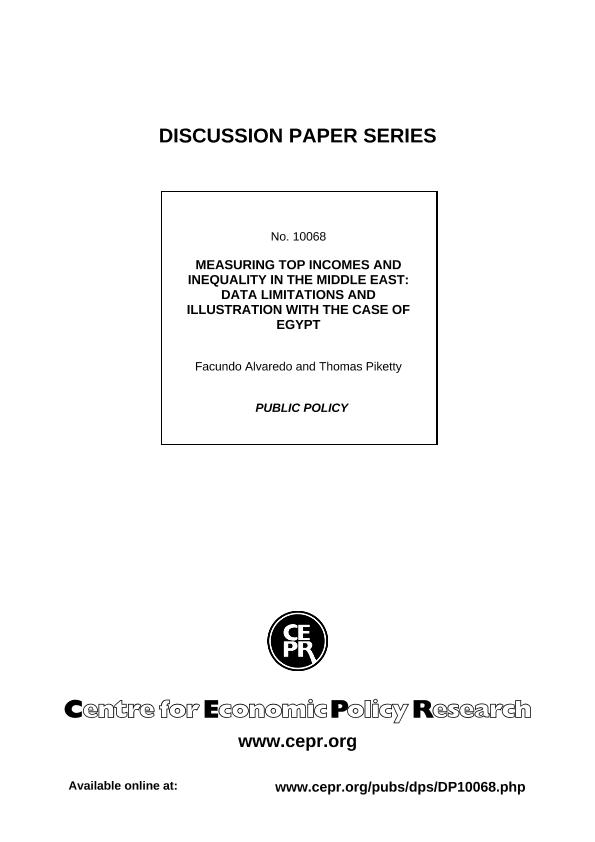Mostrar el registro sencillo del ítem
dc.contributor.author
Gonzalez Alvaredo, Facundo

dc.contributor.author
Piketty, Thomas
dc.date.available
2018-02-14T21:54:53Z
dc.date.issued
2014-07
dc.identifier.citation
Gonzalez Alvaredo, Facundo; Piketty, Thomas ; Measuring Top Incomes and Inequality in the Middle East: Data Limitations and Illustration with the Case of Egypt; CEPR; CEPR Discussion Paper Series; 7-2014; 1-60
dc.identifier.issn
0265-8003
dc.identifier.uri
http://hdl.handle.net/11336/36495
dc.description.abstract
This paper discusses the data limitations associated with the measurement of top incomes and inequality in the Middle East, with special emphasis to the case of Egypt. It has been noted that high inequality might have contributed to the Arab spring revolt movement. Some studies have argued however that measured inequality in Middle East countries is not particularly large by international standards, and that popular discontent mostly reflects the perceived level of inequality, and the perceived (un)fairness of the distribution. In this paper we review the evidence and present new estimates. We come with two main conclusions. First, data sources at the national level are insufficient to derive reliable estimates of top income shares in a country like Egypt(or in other Middle East countries). One would need reliable fiscal sources in order to make a precise comparison with other emerging or developed countries. Unfortunately, such sources are lacking in most of the region. Next, and irrespective of these uncertainties on within-country inequalities, there is no doubt that income inequality is extremely large at the level of the Middle East taken as whole-simply because regional inequality in per capita GNP is particularly large. According to our benchmark estimates, the share of total Middle East income accruing to the top 10% income receivers is currently 55% (vs. 48% in the United States, 36% in Western Europe, and 54% in South Africa). Under plausible assumptions, the top 10% income share could be well over 60%, and the top 1% share might exceed 25% (vs. 20% in the United States, 11% in Western Europe, and 17% in South Africa). Popular discontent might reflect the fact that perceptions about inequality and the (un)fairness of the distribution are determined by regional (and/or global) inequality, and not only on national inequality.
dc.format
application/pdf
dc.language.iso
eng
dc.publisher
CEPR
dc.rights
info:eu-repo/semantics/openAccess
dc.rights.uri
https://creativecommons.org/licenses/by-nc-sa/2.5/ar/
dc.subject
Egypt
dc.subject
Inequality
dc.subject
Middle East
dc.subject
Top Incomes
dc.subject.classification
Economía, Econometría

dc.subject.classification
Economía y Negocios

dc.subject.classification
CIENCIAS SOCIALES

dc.title
Measuring Top Incomes and Inequality in the Middle East: Data Limitations and Illustration with the Case of Egypt
dc.type
info:eu-repo/semantics/article
dc.type
info:ar-repo/semantics/artículo
dc.type
info:eu-repo/semantics/publishedVersion
dc.date.updated
2018-02-07T17:29:55Z
dc.journal.pagination
1-60
dc.journal.pais
Reino Unido

dc.description.fil
Fil: Gonzalez Alvaredo, Facundo. Paris School of Economics; Francia. Consejo Nacional de Investigaciones Científicas y Técnicas; Argentina
dc.description.fil
Fil: Piketty, Thomas. Paris School of Economics; Francia
dc.journal.title
CEPR Discussion Paper Series
dc.relation.alternativeid
info:eu-repo/semantics/altIdentifier/url/http://cepr.org/active/publications/discussion_papers/dp.php?dpno=10068
Archivos asociados
